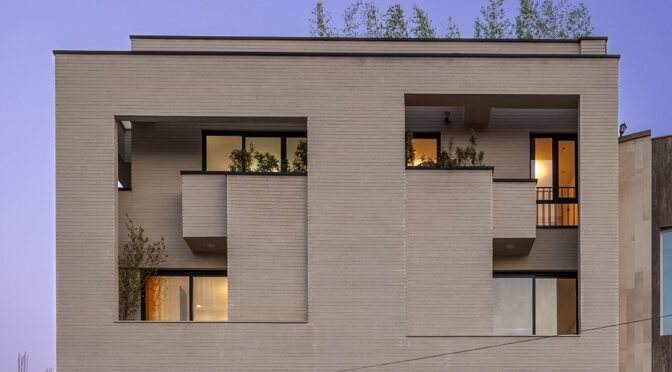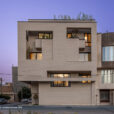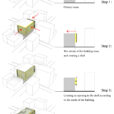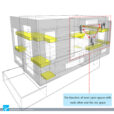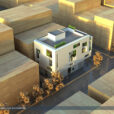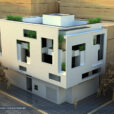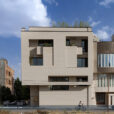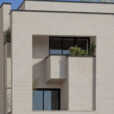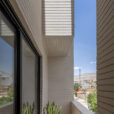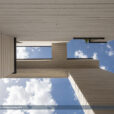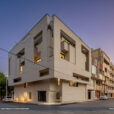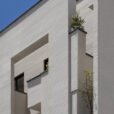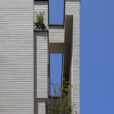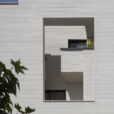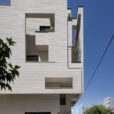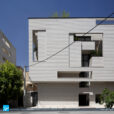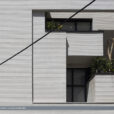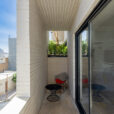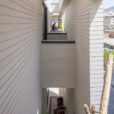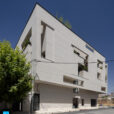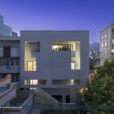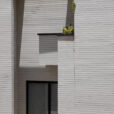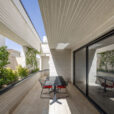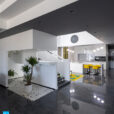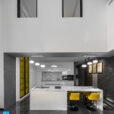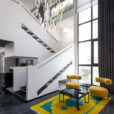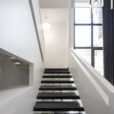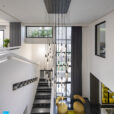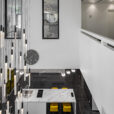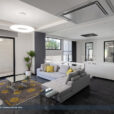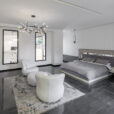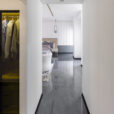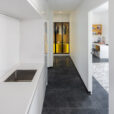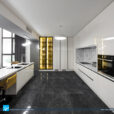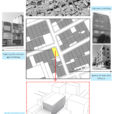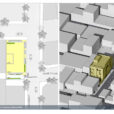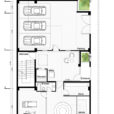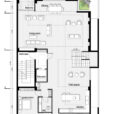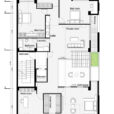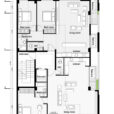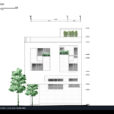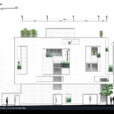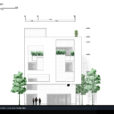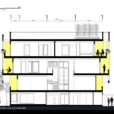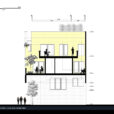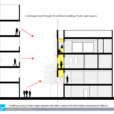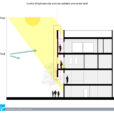ساختمان مسکونی همبود
دفتر محاط (محمد هادیانپور، رضا منصوری)
موقعیت: ایلام، ایران
تاریخ: ۱۴۰۱
مساحت: ۹۰۰ مترمربع
وضعیت: ساختهشده
کارفرما: شهرام مامی
سازه: علی احسان جوادینیا
تاسیسات مکانیکی: میثم عزیزیان
تاسیسات الکتریکی: حمید هواسی
اجرا: شهرام مامی
گرافیک: کتایون کاظمی
عکس: پرهام تقیاف
ایلام از معدود شهرهایی در ایران است که اکثر ساختمانهای آن با سطح اشغال ۱۰۰ درصد و تراکم بالا (۱۶۰ نفر در هکتار)، و بدون توجه به ایجاد فضاهای باز ساخته میشوند. شیوه شکلگیری این شهر و نیز ارزشهای ویژه مردم از منظر محرمیت و ارتباط با طبیعت، یک فضای غیرمتجانس را ایجاد کرده است که همین فضا از دیدگاه ما، بیارتباط با داشتن بالاترین آمار خودکشی کشور در ایلام نیست. از همینرو، پروژه همبود تلاش میکند بهجای انتخاب بین گفتمان شیمحور و میدانمحور در معماری، اجازه دهد تا طرح در تنش بین این دو شکل بگیرد. پروژه از منظر مسئله مطرحشده، بیگانهای است با زمینه خود که در نقش یک معماری تکپلاک، در پی تاثیر بر سیمای شهر از طریق مشروعیتبخشی به تفکر حاکم بر خود، و سپس تکثیر آن است.
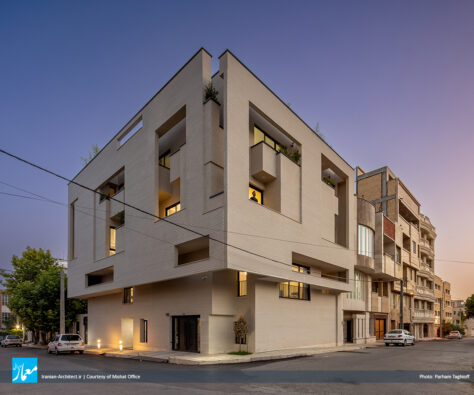
در پروژه همبود که یک آپارتمان خانوادگی است، تمرکز ما بر روی ایجاد فضاهای نیمهباز، فعالسازی آنها و ایجاد محرمیت تا عمق فضاهای داخلی بود، به شکلی که هریک از فضاهای نیمهباز پروژه نقش یک فضای قابل زیست را در ارتباط با فضای داخلی مربوطه و همچنین دیگر فضاهای نیمهباز درون ساختمان ایفا کند.
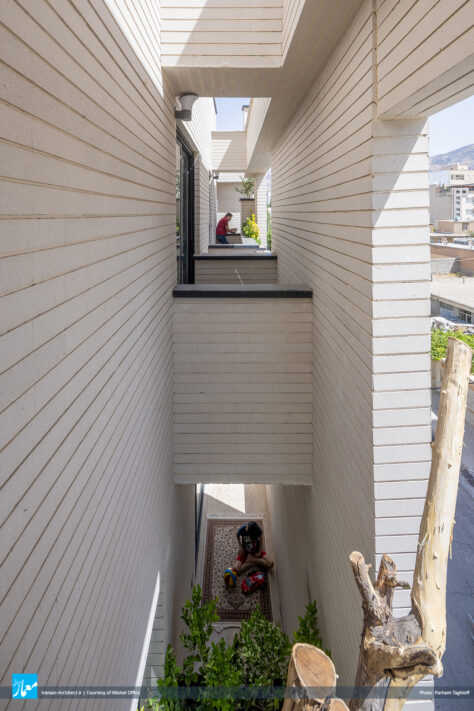
برای پاسخ به دغدغههای مطرحشده، دو پوسته را در ساختمان ایجاد کردیم تا فضاهای نیمهباز نقش فعال و نیز زیستپذیری خود را بین این دو پوسته شکل دهند. بدینترتیب، این دو پوسته در ارتباط با یکدیگر، ظرفیتهای زیر را برای حل مسائل مختلف پروژه ایجاد میکنند:
۱. امکان پوشاندن بخشهایی از فضاهای نیمهباز، با هدف خارجشدن از دید زمینه پروژه؛
۲. استفاده از تئوری خطای حسی سایه که تمرکز دید زمینه پروژه به عمق فضاهای داخلی را از بین برده و این ظرفیت را در پروژه ایجاد کرده است که از بازشوهای بزرگ استفاده شود و نیاز به پوشاندن پنجرهها به کمترین مقدار خود برسد؛
۳. تغییر الگوی رفتاری ساکنان برای صرف زمان بیشتر در فضاهای نیمهباز و حضور کمتر در فضاهای داخلی، تا از این طریق بارهای سرمایشی و گرمایشی ساختمان کاهش پیدا کند؛
۴. کنترل شدت تابش خورشید و بادهای زمستانی بر روی جداره اصلی پروژه، با هدف کاهش بارهای سرمایشی و گرمایشی ساختمان.
Hambud Residential Building
Mohat Office (Mohammad Hadianpour, Reza Mansouri)
Location: Ilam, Iran
Date: 2023
Area: 900 sqm
Status: Completed
Client: Shahram Mami
Structure: Ali Ehsan Javadinia
Mechanical Engineering: Meysam Aziziyan
Electrical Engineering: Hamid Havasi
Construction: Shahram Mami
Graphic: Katayoun Kazemi
Photo: Parham Taghioff
The city of Ilam in Iran is one of the rare cities where most of its buildings are constructed with 100% lot coverage and high density, regardless of paying attention to open-air spaces. The city’s formation and the values held by its people, have led to the creation of an incongruous space, and this space, from our point of view, was not unrelated to having the highest suicide rate in the country in this city. Therefore, the project aims to embrace the tension between an object-oriented and a field-oriented approach, rather than choosing between them. The project is an outsider that seeks to acknowledge and convey its dominant architectural idea, influencing the city’s character.
The project is a family apartment, and our focus was on creating semi-open spaces, activating them, and ensuring privacy in the innermost parts of the interior spaces. Each of these semi-open spaces serves as a habitat that is interconnected with the corresponding interior space, and also other semi-open spaces within the building.
To address the aforementioned concerns, we devised two enclosures, so that the open spaces could fulfill their active and habitable roles between these enclosures. The project offers the following capabilities to address these concerns:
1. The possibility of covering parts of semi-open spaces, to escape observation by the project context;
2. The use of the shadow illusion theory to reduce the context focus to the indoor spaces, allowing us to incorporate large windows with minimal requirements for covering them;
3. Changing the behavioral pattern of residents, in order to encourage them to spend more time in semi-open spaces, rather than indoor spaces, so that the cooling and heating loads of the building can be reduced;
4. Controlling the intensity of sunlight and winter winds on the main body of the project, to mitigate the cooling and heating loads of the building.

